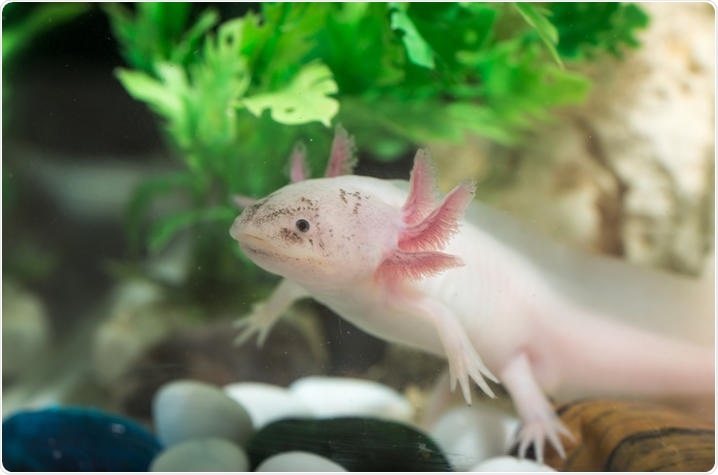Scientists from the University of Kentucky College of Medicine were part of new research that provides understanding on the advancement of limb development in vertebrates.

The UK study, which focuses on axolotl salamanders, gives insight into the evolution of limb development. Image Credit: University of Kentucky.
The researchers observed a gene that plays a crucial role in the evolution of limb development in vertebrates. The researchers manipulated this gene in mice and were able to stimulate an ancestral form of limb formation observed in early tetrapods (four-legged vertebrates). The results were published on October 4th, 2021, in the Current Biology journal.
The bones on the hands and feet on the outside edge develop first, called postaxial development, in the limbs of all tetrapods. The research concentrates on salamanders, the lone exception to this rule. The limb bones of salamanders develop preaxially, or from the inside edge; the thumb prior to pinky.
For more than 100 years, scientists have wondered if preaxial development evolved uniquely in salamanders. Now we understand that it’s ancestral to the postaxial mode seen in all other tetrapods. Salamanders are not unusual, they simply retained the ancestral mechanism of vertebrate limb development.”
Randal Voss, PhD, Study Co-Author and University Research Professor, Department of Neuroscience, University of Kentucky
Randal Voss is also the Director of the Ambystoma Genetic Stock Center.
Voss analyzes the exceptional capability of salamanders to regenerate body parts including limbs. Voss is associated with principal investigator Susan Mackem MD, PhD, with the National Cancer Institute’s Center for Cancer Research, whose study concentrates on the signaling networks concerned with limb formation.
Scientists manipulated the function of Gli3—a gene well-known in regulating the pattern of limb formation in both mice and axolotl salamanders. Mice with excess GLi3 repressor activity reversed to preaxial limb development—similar to salamanders. Contrarily, when Gli3 was “knocked out” in salamanders, the limb development was postaxial, similar to mice and all other tetrapods.
In evolutionary terms, what we’d basically done in mice is bring back the ancestral form of limb development by gene manipulation, proving that Gli3 was key for the shift from preaxial development seen in early tetrapods.”
Randal Voss, PhD, Study Co-Author and University Research Professor, Department of Neuroscience, University of Kentucky
The observations are vital for developmental and evolutionary biologists, including paleontologists who have lately observed fossils that endorse the idea that preaxial limb formation is the ancestral mode of limb development in vertebrates. The results also provide information on evolutionary questions about the transition from fins, as vertebrates gained limbs and moved onto land.
According to Voss, observations from this research will also help respond to queries on limb regeneration in the future. Salamanders are one among the few four-legged animals that can completely regenerate a limb after losing one. Researchers state that this ability is associated with their retained preaxial development.
Voss intends to analyze limb regeneration in salamanders that the laboratory genetically manipulated for postaxial development.
UK Researchers Complete Axolotl Genome Sequence (2019 Video)
In this 2019 video, UK scientists explain the implications of their work assembling the genome of the Mexican axolotl. Video Credit: University of Kentucky.
Source:
Journal reference:
Trofka, A., et al. (2021) Genetic basis for an evolutionary shift from ancestral preaxial to postaxial limb polarity in non-urodele vertebrates. Current Biology. doi.org/10.1016/j.cub.2021.09.010.